#Sikorsky Ilya Muromets
Explore tagged Tumblr posts
Text
Teicher Mammut - "Universal Carrier: People, Cargo, Bombs"
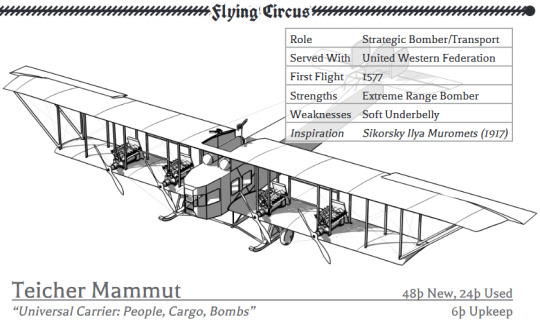
Role: Strategic Bomber/Transport Served With: United Western Federation First Flight: 1577 Strengths: Extreme Range Bomber Weaknesses: Soft Underbelly Inspiration: Sikorsky Ilya Muromets (1917)
Description:
The Teicher Mammut is famous as the first four-engine aircraft, but post-war it is often considered underwhelming due to the low power of its engines. The majority were restored to passengers and cargo carriers after the UWF fell, and those still in combat use are drastically modified.
If you are a cargo driver, however, the Mammut has much to recommend it. The glass cockpit is comfortable to fly from for long journeys, the machine is easily reconfigured for goods or passengers, and the low powered engines are fairly easy to maintain. It’s a very practical machine, if not a very powerful one.
Most Mammuts have one or two defensive turrets on the roof: The gunners climb up from the cabin to operate a pivoting gun on a stand to hopefully deter any opportunistic attackers. Wholly exposed, this position is popularly known as The Stake (Der Pfahl), a reference to the poles firing squad victims would be tied to for wartime executions.
5 notes
·
View notes
Text

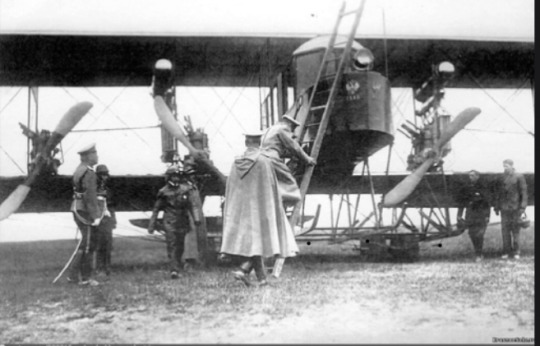
Photographs: 1 and 2: Nicholas II inspecting the four-engine biplane 'Russky Vityaz' (In 1912, the Imperial Russian Air Service, formerly part of the Engineer Corps, became a separate branch of the army. In 1913, Igor Sikorsky built the first 'Russky Vityaz'; ) Grand Duke Alexander (Sandro) Mikhailovich played a role in the moving and shaking needed for this to happen.

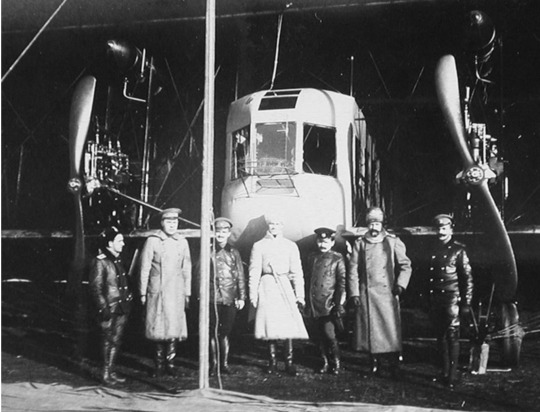
Photos 3 and 4: Also, in 1913, Igor Sikorsky built his famous bomber aircraft, the "Ilya Muromets," which appears in the two pictures above. In the photo directly above, Grand Duke Mikhail Alexandrovich is standing in front/center of the aircraft, wearing his cossack uniform. Sandro is the tall man next to last at the extreme left.


Photos 5 and 6: Sandro inspects the officers and hangars at the Officers Aviation School.
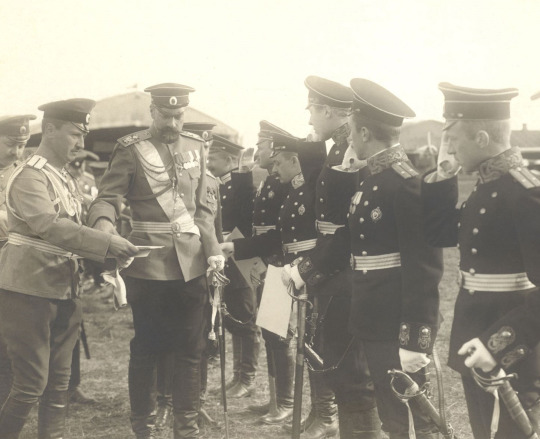
Photo 7. Sandro distributing diplomas at the Aviation School.

And in the picture directly above, Nicholas II wondering what Sandro will come up with next.
The Imperial Russian Airservice: The beginning of Military Aviation in Russia during WWI
“What next!?” Whenever I look at the picture directly above, I can "hear" Nicholas II thinking just that, with respect to his cousin and brother-in-law's interests, actions, and experiments.
Grand Duke Alexander (Sandro) Mikhailovich was a restless man of many talents and interests. Although he pursued a Naval career, his major contribution to his country and rank may be his role in the creation of the Russian Military Aviation School and the Imperial Russian Air Service.
Sandro had followed with interest the increasing sophistication of aircraft and their use for military purposes. And by 1910-1911, he was probably bored with Cannes, Biarritz, and growing seedless tangerines in the Crimea. The time was ripe for him to embark on a "project." Because of his proximity to the Tsar (he was his second cousin once removed as well as his brother-in-law, and one of the few Grand Dukes Alix got along with), he had access to the Tsar's ear (historians are still debating whether he used that access to the best advantage of his country or merely to his personal advantage.)
So Grand Duke Alexander Mikhailovich filled a need by helping create the Officer's Aviation School near Sevastopol in 1910 and later becoming the Imperial Russian Air Service chief during the First World War. Alexander held the Imperial Russian Air Service Field Inspector General position until the Bolsheviks relieved him from his duties.
At the beginning of World War I, the Imperial Russia Air Service had the largest air fleet in the world. It would be interesting to find out what happened.
#russian history#romanov dynasty#Nicholas II#Empress Alexandra Fyodorovna#Grand Duke Alexander Mikhailovich#Imperial Russia Air Service#Igor Sikorsky#Igor Sikorsky built his famous bomber aircraft#Ilya Muromets#Russky Vityaz
36 notes
·
View notes
Text
Who Invented Big Airplanes: The Minds Behind the Giants of the Sky
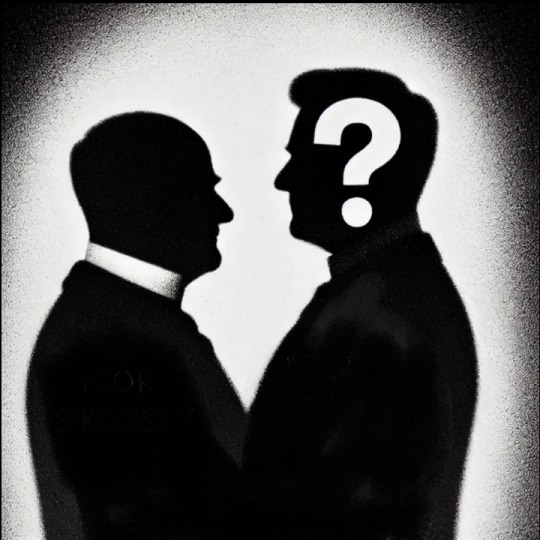
Do you know how the big airplanes were invented? It's a fascinating story that spans decades of innovation, engineering breakthroughs, and sheer determination. Big airplanes, also known as large aircraft models, have become a cornerstone of modern aviation, revolutionizing how we travel and connect with the world. But who were the brilliant minds that brought these aviation models to life?
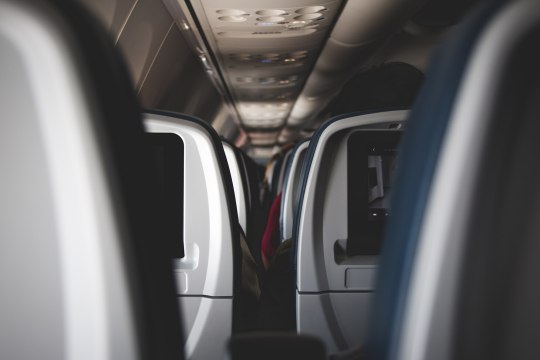
The journey of the big airplane model began in the early 20th century when aviation pioneers first dreamed of creating aircraft that could carry more passengers and cargo over longer distances. It was a time of intense experimentation and competition, with inventors and engineers racing to build the next big thing in aviation.
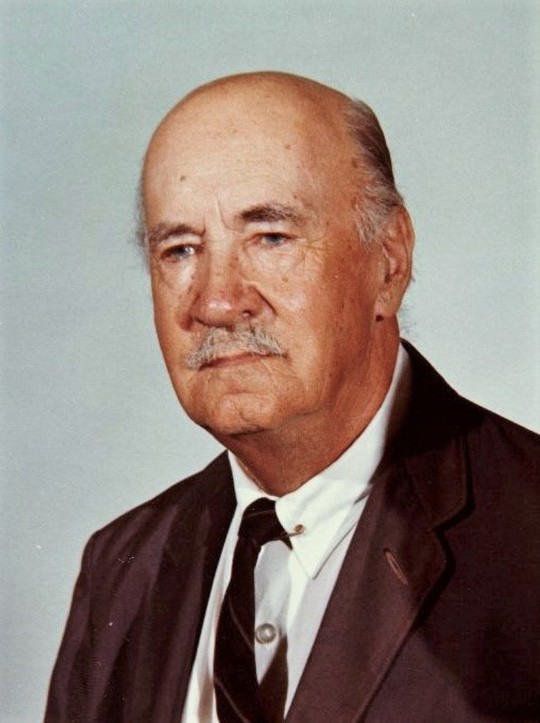
One of the key figures in the invention of big airplanes was Igor Sikorsky. Born in Kyiv, Ukraine, in 1889, Sikorsky was an aviation visionary who designed the world’s first multi-engine airplane, the Russky Vityaz, in 1913. This aircraft model was groundbreaking because it demonstrated that it was possible to create a large airplane model with multiple engines, which was essential for carrying heavier loads and flying longer distances. The success of the Russky Vityaz paved the way for the development of even larger aircraft, leading to Sikorsky’s later designs, like the Ilya Muromets, which became the world’s first four-engine bomber.
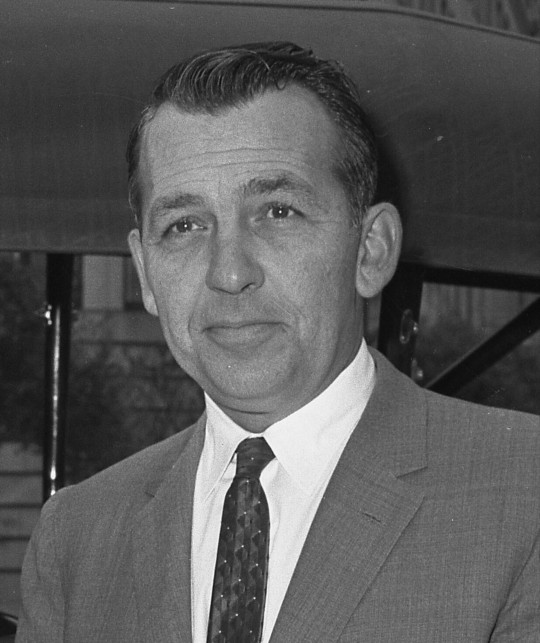
But Sikorsky wasn’t alone in his quest to build big airplanes. In the United States, Donald Wills Douglas Sr. played a crucial role in the evolution of large airplane models. Douglas founded the Douglas Aircraft Company in 1921, and it wasn’t long before his company became synonymous with innovation in aviation. One of the most significant contributions from Douglas was the DC-3, introduced in 1935. This airplane model revolutionized air travel with its ability to carry 21 passengers in comfort, a feat previously unheard of in commercial aviation. The DC-3 set the standard for modern aircraft and remains one of the most iconic aviation models ever created.

Another major milestone in the history of big airplanes came with the Boeing 747, often referred to as the "Queen of the Skies." The 747 was the brainchild of Joe Sutter, an engineer at Boeing, who led the team that designed this enormous aircraft. First flown in 1969, the Boeing 747 was a true game-changer, capable of carrying more than 400 passengers across the globe. This large airplane model not only made international travel more accessible but also solidified Boeing’s position as a leader in the aviation industry. The 747 remains one of the most successful aircraft models, with variants still flying today.
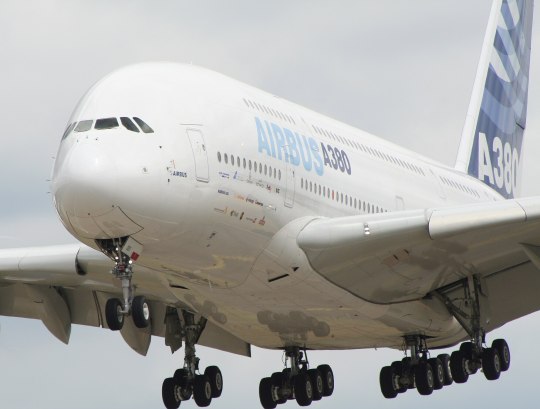
These early innovators laid the groundwork for the modern giants of the sky we see today. Today, the Airbus A380 holds the title of the largest passenger airplane model ever built. Introduced in 2007, the A380 can carry over 800 passengers in an all-economy configuration. The development of this behemoth required a multinational effort, with teams from across Europe contributing to its design and construction. The A380 represents the pinnacle of what large airplane models can achieve, offering unparalleled capacity and comfort for long-haul flights.
The invention of big airplanes wasn’t just about building larger aircraft; it was about pushing the boundaries of what was possible in aviation. These pioneers didn’t just create bigger planes; they created new opportunities for people to connect, explore, and experience the world in ways that were once unimaginable.
As aviation continues to evolve, the legacy of those who invented big airplanes lives on. From Sikorsky’s early experiments to the modern marvels of Boeing and Airbus, these aircraft models have forever changed the face of travel. So the next time you board a flight, take a moment to appreciate the incredible history behind the big airplane model that’s carrying you to your destination. The sky’s the limit, thanks to the visionaries who dared to dream big.
22 notes
·
View notes
Link
This is an add-on set for, and requires the Ilya Muromets WW I Bomber product, available in the Renderosity Marketplace. Igor Sikorsky's 1913 Ilya Muromets aircraft was a revolutionary design intended for commercial service, with a spacious fuselage incorporating a passenger saloon and small private cabin. In 1914 a prototype made a record flight from St. Petersburg to Kyiv and back. Based on historical photos and contemporaneous descriptions, this add-on converts the Marketplace bomber product to a commercial passenger transport. The add-on package includes an additional float plane conversion based in part on historical photos, that can also be applied to the original bomber version. Although designed for Poser, the additions are compatible with DAZ Studio (see Read-me for particulars). FIGUREThe poseable Ilya Muromets Transport Add-on figure has ERC controls at the Body level that:o Open the fuselage and interior doorso Open the passenger saloon windows PROPSPreloadedo Passenger Seatso Upper bridgeo Deputy Pilot Camp Seato Private cabin bunkAdditional smart propso Alternate cabin configuration with bencheso Ladder to upper bridgeo Float plane Pontoon Set POSESo Configuration - Hide bomber parts to be replaced by Transport parts - Alternate cabin configuration (benches)- Hide wheels and skids to set up for float plane- Hide Wheels for skids-only configurationo Hide/Show pose- Hide Fuselage Side for convenient visibility of cabino People poses- Deputy Pilot - Sixteen total M4 & V4 passenger poseso MATs- 2 speculative paint schemes CAMERASo Additional Dolly Camera settings for interior close-up views LIGHTSo Cabin light set (preloaded) See the ReadMe and view the product promos above for more information. In addition to the items listed in a Promo and Renderosity Products shown in the Promo Credits tab above the following resources were used to produce the promos:Menswear 1930, M4 Leather Jacket, M4 Headwear, Easy Environments Clouds, Lake Village"Low poly old stone house" (https://skfb.ly/opM9Y) by Hamerl0k is licensed under Creative Commons Attribution Required Products: Ilya Muromets WW I Bomber Software: Poser 10 / Poser Pro 2014 + Coming soon: https://3d-stuff.net/ #daz3d #dazstudio #3drender #3dart #daz3dstudio #irayrender #3dartwork #blender #blenderrender #blenderart #noaiart #noaiwriting #noai https://3d-stuff.net/
0 notes
Text

Group photo of Imperial Russian Airforce crew with the first four engine bomber ever created in History, the Sikorsky Ilya Muromets S-22, WWI, 1915 (colourised)
0 notes
Photo

Sikorsky "Ilya Muromets"
Valery Petelin
146 notes
·
View notes
Video
Replica Sikorsky S-22 Ilya Muromets - Monino by Alan Wilson Via Flickr: This is a replica of the worlds first four engined bomber. It was originally designed as a luxury airliner and the series was named 'Ilya Muromets' after a hero from Russian Mythology. 73 aircraft of this type saw military service between 1913 and 1918. It was also the first type to carry out bomber group raid, night bombing, and photo bomb damage assessment. The main production bomber was the S-23. This full scale replica is on display in the original display hangar of the Russian Air Force Museum. Monino, Russia. 13-8-2012
14 notes
·
View notes
Video
tumblr
I thought this clip was pretty awesome and ties into some Easter Eggs and thought some might find it interesting. "I am what I am, I'm Popeye the sailorman" And the brief bit with the name "Popovich". Sorry for going through a list but they are all connected. Russian Easter Eggs In The first episode Liz is picked up in a "Sikorsky" helicopter his company still maintains the real-life "Sikorsky Archive", "Sikorsky" was a Russian inventor largely responsible for the invention of helicopters who immigrated to America. "Sikorsky" also made planes the Sikorsky "Ilya" Muromets started out as an airliner but would become bomber planes in WW1. "Ilya" Muromets is a Russian Bogatyr(knight) of Legend he is often with fellow Bogatyrs Dobrynya Nikitich and Alyosha Popovich. There is a famous painting of them and they are popular in Russian culture. Alyosha "Popovich" is interesting because he is a lot like Red and it's believed he is based on Alexander Alyosha Popovich of "Rostov" who was also a master chess player from Russian history.
7 notes
·
View notes
Text
Teicher ‘Schnelles Mammut’ - "The Bomber That Always Gets Through"

Role: Fast Bomber First Flight: 1601 Strengths: Fastest Bomber Weaknesses: Miserable to Fly Backer: Victor Coronado
Description:
The “Fast Mammoth” is one of the most famous Mammut variations, the result of an alliance between engineers at the University of Heidelheim and a team of reserve bomber pilots in the immediate post-war period. The bombers were trying to stop a rampaging Leviathan, but couldn’t outrun its automated escort planes.
The solution of replacing the regular engines with four large pulsejets did allow the bombers to complete their mission, but wasn’t without downsides. The range reduction and frustration from constantly replacing broken shutters were bad, but far worse was the experience of flying it.
The noise, vibration, and heat has been described as being locked in a blast furnace during an earthquake. This rendered the machine useless as a cargo carrier or long range bomber, but deadly as a shorter ranged attack craft.
While it can’t necessarily outrun all interceptors in a straight-line fight, its speed makes safely intercepting much more difficult. The heat rays added help considerably.
4 notes
·
View notes
Text
Brain: Oh! And didn't Mercedes make a cute little grand prix race car?
Me: No!!


Brain: And didn't one of your favorite planes of all time, the Sikorsky ilya muromets, take it's first flight in 1915? Thus making it of the right era?
Me: Shut up shut up!!


Brain: 1914 Rolls-Royce
Me: Don't you dare.
Brain: Silver Ghost.


Me: I don't think I'll design anyone else for the Hearts of Steel AU. Rung was fun enough. ☺️
Brain: The 1914 GN Jap race car exists.
Me: .... DANG IT!


#transformers#hearts of steel au#Rodimus Prime#Cyclonus#Tailgate#idw tailgate#idw cyclonus#idw rodimus#I'm cursed. Cursed with car knowledge
190 notes
·
View notes
Photo

1915 Sikorsky Ilya Muromets -Tony Theobald
116 notes
·
View notes
Link
Igor Sikorsky's Ilya Muromets, conceived as a luxurious commercial transport, became an effective four-engine bomber with the outbreak of WW I. Over 80 aircraft were eventually built with numerous upgrades and variations. This Ilya Muromets model does not represent any one configuration of the bomber but contains features from several variations. The Ilya Muromets 3D model is a fully-rigged Poser figure, sized for Poser people. Although designed for Poser, it is compatible with DAZ Studio (see Read-Me). FIGUREThe poseable Ilya Muromets figure has ERC controls at the Body level that, among other things:o Move the control surfaces in concert with the pilot controls o Spin the propellerso Operate the other cockpit mechanismso Open the fuselage door and front windowo Operate the guns individuallyo Move the internal trolley to the tail gun positiono Run the bomb rack over the bomb hatch PROPSPreloadedo Madsen Machine Gunso Bomb Racks with bombso Tail Gunner Trolleyo Ammo Boxo Deputy Pilot SeatSmart propso Propeller Bluro Auxiliary Fuel Tankso Additional Bomb Rack with bombso Additional Madsen Guno Gun Bursts POSESo M4 crew poses o Configuration - Alternate Throttle configuration o Hide/Show poses- Hide Fuselage Side for convenient visibility of cabin- Hide Propellers (for use with Propeller Blur props)o Special - Poses for Cybertenko's Lewis and Maxim guns (available in the Marketplace) CAMERASo Full camera set positioned for easy viewing and rendering of the full bomber figure. Includes main, auxiliary, left, right, top, bottom, front and back cameras.o Dolly Camera settings for numerous interior and exterior close-up views LIGHTSo Simple Day and Moonlight sets See the ReadMe file and view the product promos above for more information. In addition to the Renderosity Products listed in a Promo and shown in the Promo Credits tab above the following resources were used to produce the promos:Neiwil's WW I AircraftEasy Environments CloudsXtreme Environments: Greenlands Software: Poser 10 / Poser Pro 2014 +, Daz Studio 4, Poser Pro 11 Coming soon: https://3d-stuff.net/ #daz3d #dazstudio #3drender #3dart #daz3dstudio #irayrender #3dartwork #blender #blenderrender #blenderart #noaiart #noaiwriting #noai https://3d-stuff.net/
0 notes
Text
Igor Sikorsky and his Flying Machines
By Richard DeLuca
Unlike the powered airplane, for which the Wright Brothers can be identified as the sole inventors, many people made contributions to the perfection of vertical flight between 1907 and 1942. So, it doesn’t serve accuracy to name any one person as the inventor of the helicopter. It is accurate, however, to identify Igor Sikorsky with the advent of the helicopter in the United States and with the ongoing manufacture of helicopters at the Sikorsky Aviation Corporation in Stratford.
Igor I. Sikorsky, ca. 1938
From Success in Russia to a Chicken Farm on Long Island
Igor Sikorsky was born in Kiev, Russia (which is now part of the Ukraine), and as a young man studied engineering in Paris and St. Petersburg before building aircraft of his own invention in his homeland. Young Sikorsky’s most successful design was for a large, four-engine plane that he named Ilya Muromets, after a legendary Russian folk hero. He completed it in 1913. Czar Nicolas II, who personally inspected the craft, presented Sikorsky with a diamond-studded gold watch for his efforts. Although Sikorsky had designed the Ilya Muromets to carry passengers, the military converted it to use as a bomber during World War I. It successfully flew hundreds of combat missions.
Sikorsky left Russia following the Bolshevik Revolution, which saw the overthrow of the Czar and brought such figures as Vladimir Lenin and Joseph Stalin to power. He arrived in New York City in 1919 with $600 to his name—and the Czar’s gold watch in his pocket. With encouragement from other Russian émigrés, Sikorsky began a second career as an aviation designer in 1923 and founded the Sikorsky Aero Engineering Corporation on a Long Island chicken farm owned by a fellow Russian. Here Sikorsky produced twin-engine seaplanes. In the days before airports were commonplace, airlines used seaplanes to provide air mail service to warm-water ports, where the water became the runway.
Innovation Takes Root in Connecticut
With more orders for his “flying boats” than he could accommodate at the New York farm, Sikorsky moved his airplane manufacturing operation in 1929 to a new factory in Stratford, Connecticut. It was situated at the mouth of the Housatonic River so that he could test his aircraft on Long Island Sound. Reorganized as the Sikorsky Aviation Corporation, the company created a line of larger, more powerful seaplanes, including the famous clipper series used by Pan American Airways to expand international air service in the 1930s.
Pontoon construction at the Vought-Sikorsky Aircraft Corporation, Stratford – Library of Congress, Prints and Photographs Division
As land-based aircraft became more reliable, cities across the country constructed new airports and orders for flying boats dwindled. Instead of closing shop, Sikorsky returned to his long-held dream of vertical flight and began a third aviation career as a designer of helicopters. Although many had worked on the helicopter concept over the decades, none had solved the complex problems associated with control of this temperamental, light-weight aircraft.
Unlike those whose designs relied on multiple rotors to lift the craft off the ground, Sikorsky focused on the possibility of a single main rotor; this produced encouraging results. The more difficult problem was the number and arrangement of the tail rotors that kept the aircraft from spinning out of control once aloft. After several years and several experimental models, Sikorsky discovered that a single rotor mounted vertically on the tail of the aircraft worked best, and on January 14, 1942, Sikorsky himself piloted the first successful test flight of the helicopter in America. The flight established a standard for the future development of the helicopter and in the process made the Sikorsky Aviation Company a leader in helicopter design.
Many, Sikorsky included, hoped that the helicopter might become a vehicle for personal travel, as commonplace as the automobile. But the advanced skill required to fly a helicopter kept it from becoming a family vehicle. Instead, the helicopter became largely a rescue aircraft, able to take off and land in restricted areas and to hover at sea. With the onset of conflicts in Korea and Vietnam, the military used the helicopter extensively as a troop carrier, gunship, and medical evacuation vehicle. Today, the military, together with civilian rescue teams, remain the prime customers for helicopter sales. Meanwhile, Sikorsky Aviation Corporation of Stratford, today a division of United Technologies Corporation, has remained a major producer of helicopters for an international market.
Richard DeLuca is the author of Post Roads & Iron Horses: Transportation in Connecticut from Colonial Times to the Age of Steam, published by Wesleyan University Press in 2011.
from Connecticut History | a CTHumanities Project https://connecticuthistory.org/igor-sikorsky-and-his-flying-machines/
0 notes
Text
Masterminds: engineers who changed aviation
on 24th May 2020
INA HLADYSHAVA
FOLLOW
Masterminds: engineers who changed aviation
Share this news
Being a pilot is a fascinating calling, deservedly admired by all. A bit more neglected but just as important is the merit of engineers and aviation technicians who make planes fly and keep the industry going. Today, on May 24, AeroTime Hub celebrates the genius of people who work behind the scenes of aviation.
From fixing bicycles to levitating the first aircraft
The holiday originates from the legacy of Charles Edward Taylor – an American engineer who created the engine for the world’s first plane. A pioneer of design and maintenance of the original aircraft engines, interestingly enough, found himself in the industry by a fluke.
Born on May 24, 1868, in a small city of Illinois, the U.S., Charles Edward Taylor was a toolmaker specializing in farm machinery and bicycles. The Wright Brothers, who in the 1890s owned a bicycle company, hired him as a mechanical engineer and repair specialist. As the company’s scope started to expand to the aeronautical segment, Taylor was compelled to switch specialty too.
To create their first flyer, the Wright Brothers needed an off-the-shelf engine with at least 8 horsepower, which was not available in the U.S. at the time. The brothers decided not to look for international providers of engines. Instead, they asked Tailor to build one. What Taylor managed to do was unthinkable – based on the rough sketches of the Wright Brothers, he designed and built an entire engine prototype in just six weeks. The aircraft engine was of 12 horsepower.
Charles Taylor and Wilbur Wright attach a canoe on a new Flyer, 1909
Prophesying potential danger of airplanes or fearing Taylor might leave for a career as an exhibition pilot, the Wright Brothers refused to teach Taylor to fly despite his want. So, he went on maintaining planes. During one of the demonstration flights, there was an accident. The plane jolted and hit the ground, killing one of two people on board. It was Taylor who scrutinized the case, becoming the first person ever to investigate the fatal plane crash. It was also him who found out that the delamination of the freshly installed propellers had led to the accident.
With his contribution largely forgotten until 1937, this leading mechanic in the Wright Brothers’ shadow was essentially the person who made the flight possible.
Ahead of his time with delta wing, VTOL and rocket-powered fighters
A true engineering maverick, Alexander Martin Lippisch’s work provided a basis for delta wing – an aircraft configuration that proved to be effective for both supersonic jets and fighters.
Alexander Lippisch was born in Munich, Bavaria, in 1894. Enforced to abandon his dreams about art school because of the First World War, Lippisch snatched his bit of creativity while serving in the German Army where he learned aerial photography.
After the war, Lippisch worked for the renowned Zeppelin company. This is where his interest in engineering with particular attention to tailless aircraft emerged. In 1921, Lippisch’s first aircraft design saw the light: Espenlaub E-2 glider. The project would result in dozens of plane designs he made through the 1920-1930s. His tailless aircraft, gliders Storch I – Storch IX, swiftly caught the interest of private companies and the government.
Alexander Martin Lippisch and his tailless aircraft Storch V, 1932
Pioneering aerodynamics and bizarre plane designs, Lippisch was also working with VTOL unmanned aircraft concept before it had become mainstream. The Dornier Aerodyne was his vision of a wingless vertical take-off and landing aircraft. Despite successful flight tests in 1972, the development was not over due to a lack of interest from the German Air Force.
Lippisch made an enormous contribution in understanding tailless aircraft, delta wings and the ground effect. During his work, Alexander Martin Lippisch offered and developed more than 50 radical plane designs including the speedy rocket-powered interceptor Messerschmitt Me 163 Komet.
The father of helicopter industry and aeronautical pioneer
Russian-American scientist and engineer Igor Sikorsky was the creator of the world's first four-engine aircraft, heavy four-engine bomber, passenger aircraft Ilya Muromets, a transatlantic seaplane, and a serial single-rotor helicopter.
A man who would boldly mark himself a place in the aviation history books was born in Kyiv, Russian Empire, in 1889. Igor Sikorsky’s curiosity for engineering and aviation came from novels of Jules Verne his mom used to read for him. At 12, the boy managed to build his first small helicopter model and even made it fly using rubber as a homing.
Once, traveling to Bavarian Alps in 1908, Sikorsky saw German newspapers flashing with stories about the Wright Brothers’ flights and the first airships of Zeppelin. Curious and inspired, Sikorsky assembled a heavy helicopter model right in his hotel room. It could even fly a few centimeters. Sikorsky knew straight away: if there were a more powerful engine to it, he could make a real helicopter.
Sikorsky's four-engine aircraft, the Russian Knight, 1913
In 1910, Sikorsky moved on to more conventional fixed-wing aircraft with the company Russo-Balt. He was not done with experimenting though. This was also the year when he put to the test “aerosani”, a propeller-driven snowmobile of his own development. In 1913, he built the first four-engine aircraft in the world, the Russian Knight. The concept would later be reused for the Ilya Muromets bombers that served in the First World War.
It wasn’t until 1930 that Sikorsky would come back to his first passion, helicopters. In 1939, he produced a viable prototype, the Vought-Sikorsky VS-300, the first successful helicopter to use a single vertical-plane tail rotor configuration for anti-torque. This design would be then adopted for most helicopters becoming a clear benchmark for up until now.
from JC's Aviation https://ift.tt/2A9UlD6 via IFTTT
0 notes



